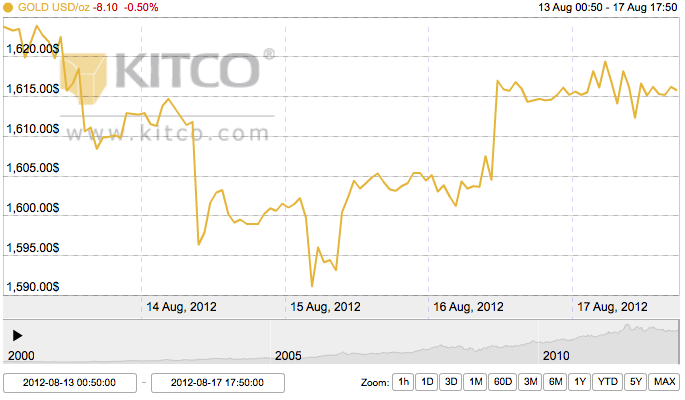Monday Open: $1,623.60
Weekly High: $1,623.60
Weekly Low: $1,591.10
Friday Close: $1,615.80
This week’s price of gold story unraveled too similarly to the one that’s been told every week this summer; investors are getting anxious at the lack of change in the market, yet are still mildly hopeful for an upcoming change of events. The three major factors that have kept gold in state of limbo for the first half of 2012 have not improved – the U.S. Federal Reserve has not eased monetary policy, the European Central Bank is slow to enact financial safety measures, and China and India have actually decreased their gold demand. This week saw some especially drab news in the world of gold investing, especially in terms of the global economy, but it was tempered by a new billionaire investor and a survey by Kitco that reports that gold bulls are still a majority.
Monday opened above the $1,600 mark, but that was the highest it would be all week. Early in the week, gold fell as bleak economic reports started tumbling in across the major nations. Japan, China, the U.S. and the European Union all reported economic stagnation without any concrete action to bolster paper reserves or otherwise buffer the commodities market. Gold rises as a hedge fund in relation to the dollar, the euro and commodities like oil, so the lack of movement in these realms translates to a lack of movement for gold.
Tuesday took a slight upturn after some fresh, weak U.S. economic data, but it didn’t last long. A slew of negative data started pouring in as the week wore on, including some statistics from the World Gold Council. According to this gold watchdog organization, gold dropped 7% in the second quarter compared to where it was last year at this time, and jewelry demand fell 15%. Alarmingly to gold bulls, 56% of this drop in gold demand occurred in India, which is well-known to be a powerhouse of gold consumption. A weak rupee and sluggish economic growth may have a hand in that. Also, it came to light on Tuesday that six more European nations are now in an official recession. With gold retreating for four quarters in a row, some may be asking: is the gold rush is over?
It’s hard to say, according to most speculators, but it does depend on a few factors, like central bank policy and the economic health of India and China. George Gero, vice president of RBC Global Futures, had this to say: “Unless we start to see some effect of stimulus, traders are concentrating on what is now. If traders can’t find something positive to point to, they tend to shy away from taking risks.”
And nothing drastic has changed in terms of Fed or ECB policy. The next meeting of the Fed is scheduled for August 31, but it’s hard to say whether any significant policy changes will be enacted. Still, this is the next date on the waiting list for gold investors.
Thursday and Friday saw an increase in the market, so that the week closed only about $5 below the week’s beginning.
But it’s still the same waiting game, and as the chief economist of precious metals trading company Degussa Goldhandel GmbH said, “The monetary affairs of the world probably play the most important role for gold prices going forward. The slowing economy will boost calls for easier monetary policy.” Depending on how central governments and banks respond, gold could see a green light ahead. Out of Kitco’s weekly respondents, 16 of 28 still feel optimistic.
In other somewhat positive news, billionaires George Soros and John Paulson increased their gold holdings, driving confidence to some in the market.

Leave a Reply